Dia del los Muertos: Unpacking Cultural Appropriation in My Middle School Spanish Class
Contributor: Lena Dalke
When I started teaching Spanish eight years ago, very few of my students knew about Día de los Muertos and those who did had family or friends who celebrated the holiday. Over the past few years, though, I’ve noticed that more and more students had some familiarity with the holiday, although they often described it as the “Mexican halloween.” But it wasn’t until some of my own students excitedly told me that they were going to “dress up like day of the dead” for Halloween a couple of years ago, that I realized that I needed to change something about my approach. In additional to learning Spanish vocabulary words related to Día de los Muertos, I wanted my students to grapple with the ramifications of taking elements of a culture that wasn’t their own, and to think about how that might affect others, especially in light of power dynamics between the United States and Mexico. I also wanted them to think about the connections between how colonization changed the pre-hispanic cultures and current issues around cultural appropriation. Yet, I also knew I wanted to tread lightly so as to not stifle my students’ enthusiasm about learning about the holiday, or other cultures in general.
To build background about cultural appropriation, I used Nik Moreno’s article called The History of Día de los Muertos and Why You Shouldn’t Appropriate It, and I also showed segments of Franchesca Ramsey’s 7 Myths about Cultural Appropriation DEBUNKED!. We explored the difference between assimilation (when someone is forced to take on another culture in order to fit in or survive in a different country) versus appropriation (when someone takes parts of a culture or holiday that’s not theirs for their own enjoyment or benefit). At the beginning of our discussions, most of my students’ sentiments were that it was okay to celebrate a culture that is not your own, but they recognized that there is a fine line between being respectful and disrespecting the holiday.
As the conversations continued, we discussed whether or not it felt respectful to take parts of one holiday and celebrate it during another holiday. It was interesting to me to find that many of my sixth grade students had already been thinking about cultural appropriation in different contexts of their lives. One student shared a personal connection about going to the Chinese New Year’s Day parade as being respectful appreciation as a white person, but dressing up in a costume worn during the Chinese New Year’s Day parade for Halloween as not being respectful. Another student shared that she had with a friend of hers who was not Jewish but wanted to celebrate Hanukkah in a way that felt more like Christmas. She said, “You can’t do that. I have no problem with her celebrating it, but you can’t celebrate a different culture and change it.” Throughout the conversations, students who initially did not think that there was anything wrong with celebrating other holidays started to show understanding for the times and situations in which it wouldn’t be respectful. A student summarized our general consensus that we came to: “It’s not okay to take one part of a holiday and put it into another holiday because it’s kind of disrespectful because you’re not celebrating what that other holiday is really for.”
The most powerful moment for me this year was with my 7th grade class, with students whom I had started these conversations with last year. One of the students shared an incident that had occurred on Halloween when she was trick-or-treating and saw someone dressed up as a stereotype of the holiday. She asked the person why they were dressed like that, and she informed them more about Día de los Muertos. She explained that it’s not a costume, it’s a holiday. In this small interaction, it was clear to me that this student was embodying one of our school’s core values of honoring ourselves and others, and was also empowered to act as an upstander when she saw that someone was not being thoughtful about the holiday. By sharing her experience with her class, she inspired her classmates to identify other ways that they could be upstanders in the face of cultural appropriation, by educating others and using social media.
For me, the insights that come from these conversations confirm the importance of talking about these issues with this middle school students. Additionally, it also gives me hope that if people start to contemplate the implications of cultural appropriation at the age of 11 or 12, that they will be able to gain a much deeper understanding of the complexities of cultural exchanges as they get older.


